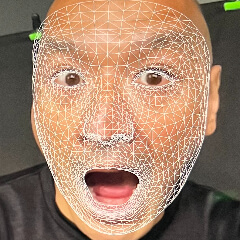
New: AI passthrough!
This amazing JillVR feature uses the power of AI to turn every VR scene into AR passthrough! Now you can take characters out of VR and have them right there with you - as if they were in the same room.
Notice: AI Passthrough is presently in beta mode, and as such, users may encounter occasional service imperfections. The feature is currently exclusive to the DeoVR app, but it will soon be accessible on both browsers and mobile devices. Your feedback is highly encouraged and appreciated.
Recommended headsets:
Meta Quest 3, and Quest Pro with stereoscopic color passthrough, Pico 4 (monoscopic color passthrough).
Compatible headsets:
Quest 2, Valve Index (monoscopic black and white passthrough).
Passthrough is not compatible yet for Oculus Link cable.
Check out our complete guide to passthrough and join in the discussion at our busy forum.
Takoyaki (たこ焼き or 蛸焼) is a ball-shaped Japanese snack made of a wheat flour-based batter and cooked in a special molded pan. It is typically filled with minced or diced octopus (tako), tempura scraps (tenkasu), pickled ginger (beni shoga), and green onion (negi).[1][2] The balls are brushed with takoyaki sauce (similar to Worcestershire sauce) and mayonnaise, and then sprinkled with green laver (aonori) and shavings of dried bonito (katsuobushi).
Yaki comes from yaku (焼く), which is one of the cooking methods in Japanese cuisine, meaning 'to grill', and can be found in the names of other dishes in Japanese cuisine such as okonomiyaki and ikayaki (other famous Osakan dishes).[3] Typically, it is eaten as a snack or between meals, but in some areas it is served as a side dish with rice. It is an example of konamono (konamon in the Kansai dialect), or flour-based Japanese cuisine.
https://en.wikipedia.org/wiki/Takoyaki



















![360 VR] summer vacation ep.5 360 VR] summer vacation ep.5](https://cdn-vr.jillvr.com/images/72527/67128_-vr-summer-vacation-ep-cover-app.jpg)

![3D VR] date with her B teaser. 3D VR] date with her B teaser.](https://cdn-vr.jillvr.com/images/61097/17948_d-vr-date-with-her-b-teaser-cover-app.jpg)
![360 vr] with date her C ep.1(English subtitles included) 360 vr] with date her C ep.1(English subtitles included)](https://cdn-vr.jillvr.com/images/61065/88432_-vr-with-date-her-c-ep-cover-app.jpg)
![360 VR] summer vacation ep.8 360 VR] summer vacation ep.8](https://cdn-vr.jillvr.com/images/72531/67229_-vr-summer-vacation-ep-cover-app.jpg)
![360 VR] summer vacation ep.7 360 VR] summer vacation ep.7](https://cdn-vr.jillvr.com/images/72530/91801_-vr-summer-vacation-ep-cover-app.jpg)
![3D VR] date with her C teaser. 3D VR] date with her C teaser.](https://cdn-vr.jillvr.com/images/61098/58127_d-vr-date-with-her-c-teaser-cover-app.jpg)


![360 vr] with date her B ep.1(English subtitles included) 360 vr] with date her B ep.1(English subtitles included)](https://cdn-vr.jillvr.com/images/61064/95149_-vr-with-date-her-b-ep-cover-app.jpg)




